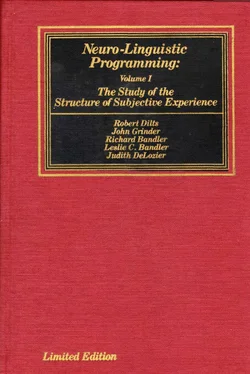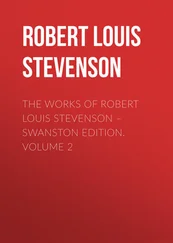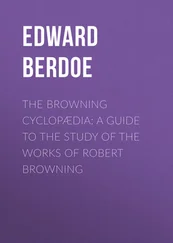Step 3. (Optional). Get a full 4–tuple for the experience by taking the person through each of his sensory systems, focusing both internally and externally, and checking which are operating during the state. For example:
How do you feel inside when you are in this state? (K i)
Do you have any external body awareness? (K e)
Where and how fast are you breathing when you are in this state? (K c)
Do you have any internal dialogue? (A i d)
How well do you hear what's happening around you? (A e)
What does your own voice sound like when you are in this state? (A e t)
Can you see clearly what is going on around you? (V e)
Do you see anything in your head? (V i)
How well can you smell in this state? (O e)
Are you remembering any smells or tastes? (O i)
Use your sensory experience to make sure that they are checking each of these systems, and calibrate to make sure all accessing is of the same intensity. As they access each portion of the experience anchor each one on the left knee. You will then have anchored the entire 4–tuple. We can notate this in the following way:
∮ 1→ e,i 1, V e,i 1, K e,i 1, O e,i 1>
This shows that anchor number one, "∮ 1", elicits state number one.
Step 4. Continue to test and reinforce the anchor until you are satisfied that it has been solidly established. It is not necessary that the individual know consciously what you are doing for the anchor to be effective. Nor will the person's awareness of what you are doing interfere with the process, unless it is keeping him from accessing the information you want. It will be up to you to decide whether to tell the person what you are doing or not. (You may also wish to have the person establish a self controlled anchor as a resource.)
Step 5. Next, ask the individual if there is some situation or task in which he typically find himself inefficient or blocked. As the individual discusses the situation, anchor it by reaching out with your right hand and placing it on the person's left knee. Again, use your sensory experience to make sure you are anchoring at the appropriate times.
Step 6. (Optional) Repeat the process of getting a full 4–tuple representation of this second state, anchoring each aspect of the 4–tuple as you observe it come up. You will then have an anchor for the problematic state:
∮ 2→
e,i 2, V e,i 2, K e,i 2, O e,i 2>
Step 7. Keep testing and reinforcing the anchor until you are satisfied that it has been solidly established.
Step 8. Reach out with both hands and touch off both anchors simultaneously. This will force the two patterns of behavior (as represented by the 4–tuples) into the same time and space neurologically such that a third 4–tuple (or sometimes a set of 4–tuples) will be formed that integrates the other two. The resource experience will be combined with the inefficient experience in such a way that the individual will typically spontaneously generate new choices of behavior in the situation that has formerly been a problem.
We can notate the process of integration as:
∮ 1+∮ 2→ e,i (1*2), V e,i (1*2), K e,i (1*2), O e,i (1*2)>
This shows that at the simultaneous firing of the two anchors, the 4–tuples combine to make a third. The star function, "*", represents a function of combination of the sensory parameters of the two states. The manner in which this combination takes place will, of course, not be simply additive but will depend on the strength and content of the representations, and the neurological attributes of the individual.
This exercise involves the use of tactile anchors. We suggest that you also go back through the exercise with a different person (or with the same person, using different subjects) and repeat the process using visual, auditory and olfactory anchors. You can generate these anchors through your own behavior, with gestures and tonal and tempo changes, and also use other available stimuli.
For example, you may use almond and vanilla extract as olfactory anchors. For a visual anchor you may instruct an individual to fold a piece of paper in half and on one side have the person draw a picture representing himself in a problematic state. The kinds of questions listed earlier would be asked to elicit a full representation that would become anchored to the drawing. Then have the individual turn the half–page over and draw a picture representing a resourceful state, and again elicit a full representation. Finally, have the individual open the paper so that both sides are showing simultaneously. This will visually accomplish the same result as the simultaneous firing of the two kinesthetic anchors.
The same process may also be undertaken by having the individual choose two songs or pieces of music that are representative of the two states in question, by eliciting a full representation as the song is being played, and then playing both of the songs simultaneously.
EXERCISE C— Creating Experience Through Anchoring:
In the same way that 4–tuples may be integrated by anchoring them together, various representations from completely different 4–tuples may be anchored together to create a new 4–tuple. Because internally generated experience utilizes the same neural pathways as externally generated or "actual" experiences, creating new 4–tuples in this way can be as powerful and effective as if the individual had "really" had the experience.
In this process the external sensory parameters of one 4–tuple (identifying the external context of the experience) are generally tied with internally generated representations (making up the individual's internal response) of another 4–tuple.
Step 1. Sit down with an individual and ask him if there is any situation in his life that he recurrently finds himself in that he isn't comfortable but would like to have the choice of enjoying.
Step 2. As he describes the situation reach out and touch his left knee only when he describes the external aspects of the situation. Ask questions about the external context of the situation — what the situation looks, sounds, feels and smells like externally — and anchor them. We will call this situation "1". This process can be notated as:
i,e 1, V i,e 1, K i,e 1, O i,e 1> → ∮ 1e 1, V e 1, K e 1, O e 1>
Step 3. Ask the individual to describe something that they enjoy. Anchor only those representations that are indicative of the individual's internal response by placing your hand on their right knee. Ask questions concerning internal dialogues, images, feelings, tones and smells and anchor each respectively. We can show this visually as:
i,e 2, V i,e 2, K i,e 2, O i,e 2> → ∮ 2i 2, V i 2, K i 2, O i 2>
Step 4. Simultaneously touch off the anchor for the external representations of the context which is typically unenjoyable and the anchor for the internal response to the situation that is enjoyable. This serves to pair the representations such that the external representations can trigger the enjoyable internal representations. If the individual has recreated the external circumstances closely enough, then when he or she returns to that environment it should also serve to trigger the enjoyable response. This can be shown as:
∮ 1+∮ 2→
e 1, A i 2, V e 1, V i 2, K e 1, K i 2, O e 1,O i 2>
As an added measure, you may ask the individual to imagine what the experience would be like if he were able to enjoy himself in that situation as you "fire off" the anchors in unison. You may also ask the individual to think of some time in the future when he will encounter this situation and, as you hold both of the anchors, ask him to describe how his experience will change in this instance. This kind of process is called a "future pace", and helps to insure that the response becomes wired to the appropriate stimuli.
Читать дальше











